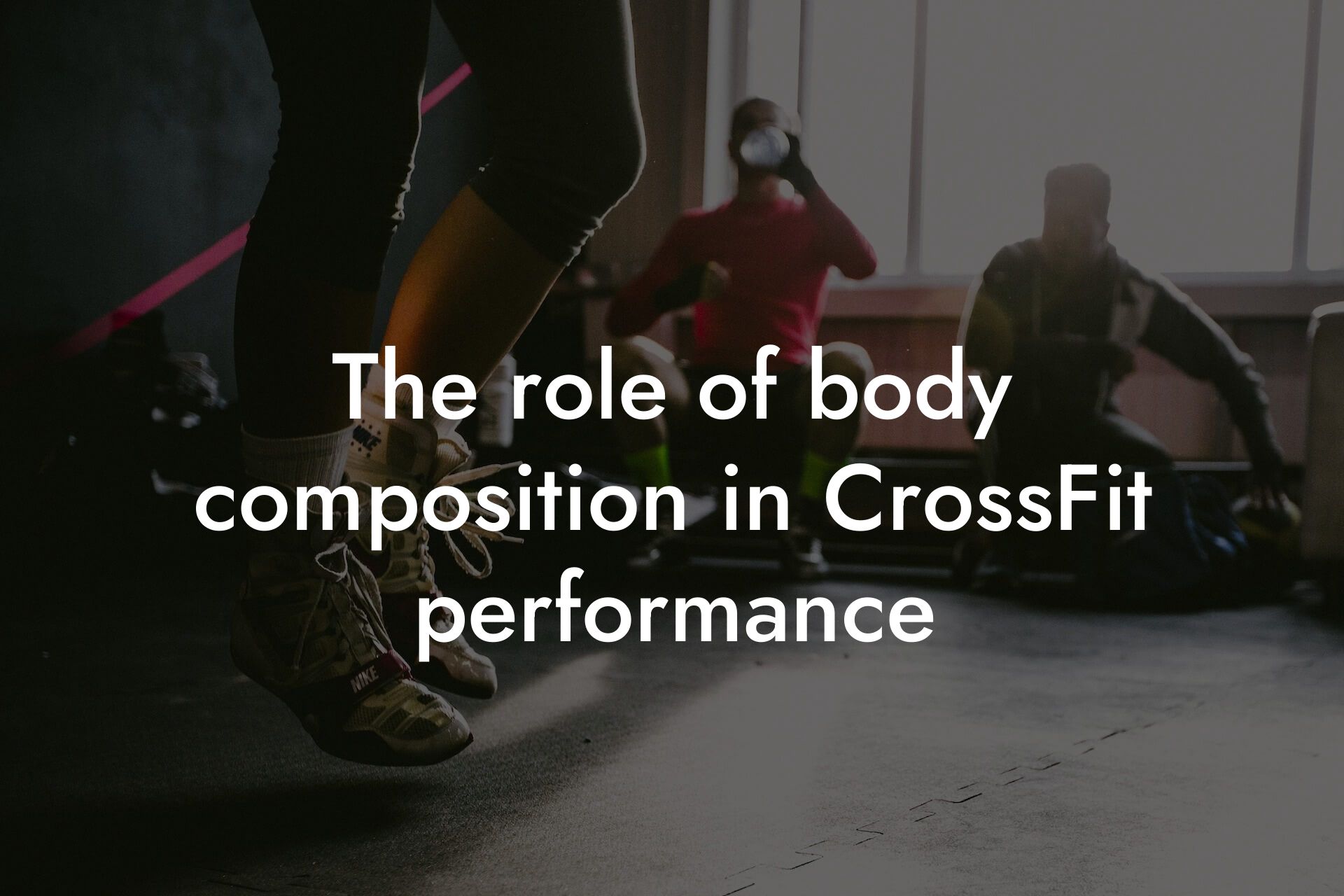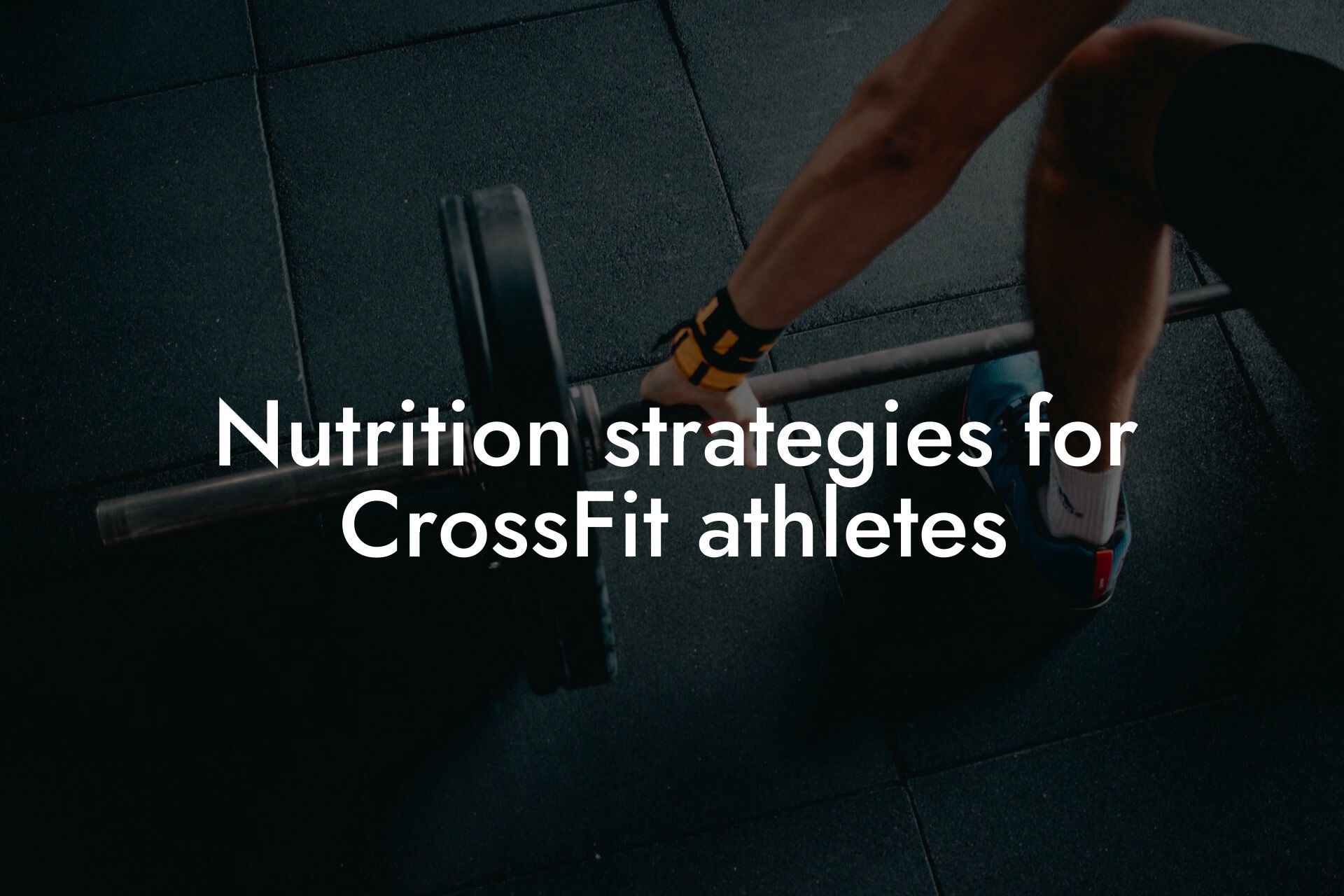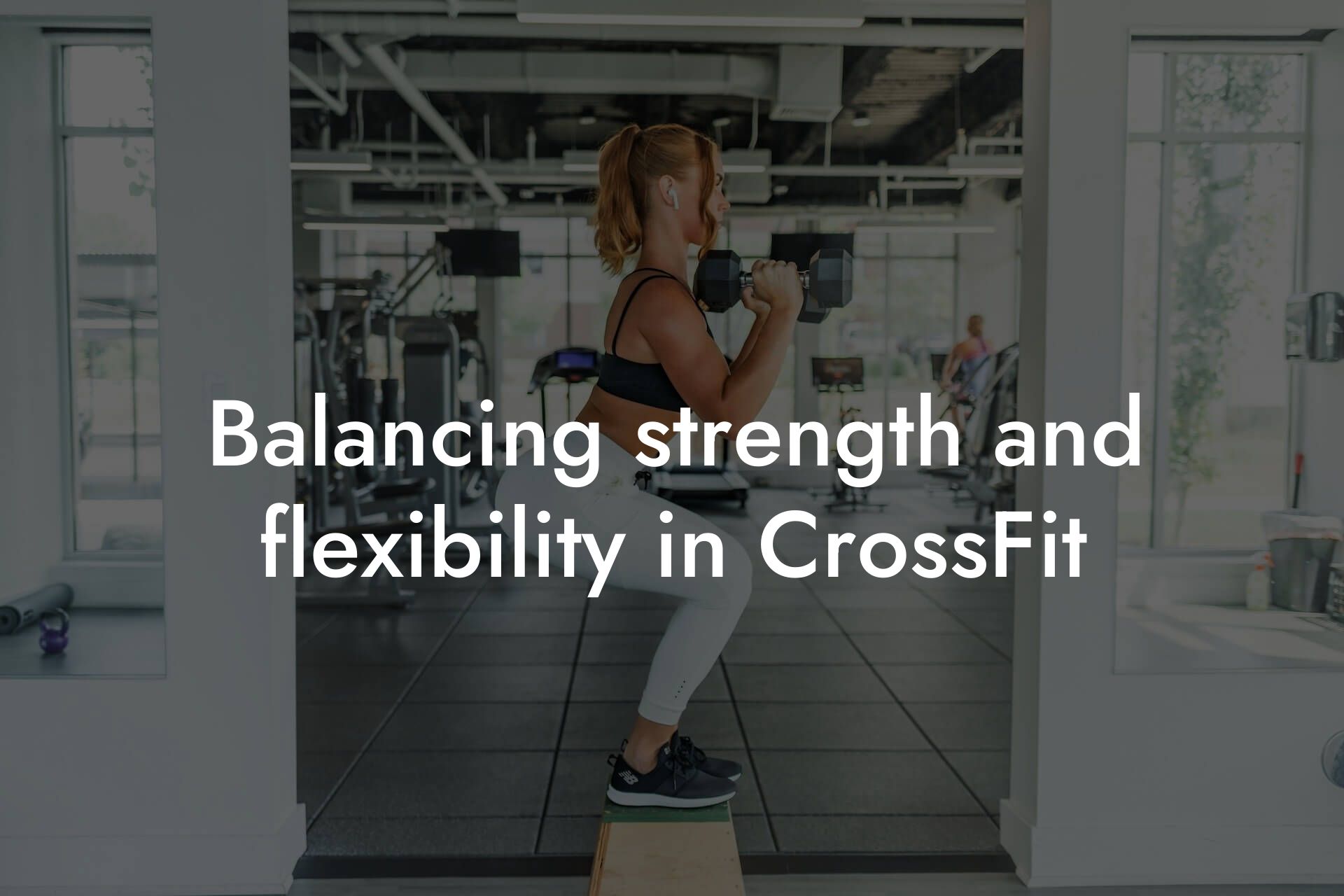As a high-earning professional, you understand the importance of optimizing your physical performance to stay ahead in your career. CrossFit is an excellent way to improve your overall fitness, but having excess body fat can hinder your progress and performance. In this article, we'll delve into the importance of reducing body fat for better CrossFit performance, and provide you with actionable tips and strategies to achieve your goals.
Table of Contents
Why Body Fat Matters in CrossFit
Body fat plays a significant role in CrossFit performance. Excess body fat can increase your risk of injury, reduce your power output, and decrease your endurance. When you have too much body fat, you're carrying around extra weight that your muscles need to work harder to move, which can lead to fatigue and decreased performance. Additionally, excess body fat can also affect your mental game, making you feel sluggish and unmotivated.
In contrast, having a leaner body composition can improve your CrossFit performance in several ways. You'll be able to move more efficiently, generate more power, and recover faster between workouts. A leaner body composition can also boost your confidence and motivation, helping you to push yourself harder and achieve your fitness goals.
The Ideal Body Fat Percentage for CrossFit
So, what's the ideal body fat percentage for CrossFit? The answer varies depending on your goals and gender. For men, a body fat percentage of 10-15% is considered optimal for CrossFit performance. For women, a body fat percentage of 15-20% is ideal.
It's essential to note that body fat percentage is just one aspect of overall health and fitness. You should also focus on building lean muscle mass, improving your bone density, and enhancing your overall physique.
How to Measure Body Fat Percentage
There are several ways to measure body fat percentage, including:
- DEXA (Dual-Energy X-ray Absorptiometry) scan: This is a highly accurate method that uses X-rays to measure bone density and body composition.
- Hydrostatic weighing: This method involves weighing yourself underwater to estimate body fat percentage.
- Skinfold measurements: This method involves pinching your skin at various points on your body to estimate body fat percentage.
- Bioelectrical impedance analysis (BIA): This method uses a device to send an electrical current through your body to estimate body fat percentage.
At Tano Performance Group, we use DEXA scans to provide our clients with a comprehensive body assessment, including body fat percentage, lean muscle mass, and bone density.
Nutrition Strategies for Reducing Body Fat
To reduce body fat, you need to focus on creating a calorie deficit, which means consuming fewer calories than your body burns. Here are some nutrition strategies to help you achieve your goal:
- Eat protein-rich foods: Protein takes more energy to digest than carbohydrates or fat, which can help increase your metabolism and reduce body fat.
- Increase your fiber intake: Fiber can help you feel fuller for longer, reducing the likelihood of overeating and consuming excess calories.
- Focus on whole foods: Whole foods such as fruits, vegetables, lean meats, and whole grains provide essential nutrients and fiber, making it easier to stick to your diet.
- Reduce your carbohydrate intake: Consuming too many carbohydrates can lead to insulin resistance, which can make it harder to lose body fat.
- Stay hydrated: Drinking plenty of water can help suppress appetite and boost metabolism.
Training Strategies for Reducing Body Fat
In addition to nutrition, your training program also plays a crucial role in reducing body fat. Here are some training strategies to help you achieve your goal:
- Incorporate high-intensity interval training (HIIT): HIIT involves short bursts of high-intensity exercise followed by brief periods of rest. This type of training can help you burn more calories in less time.
- Focus on strength training: Building lean muscle mass through strength training can help increase your metabolism and reduce body fat.
- Incorporate plyometric exercises: Plyometric exercises such as jump squats and box jumps can help improve your power output and burn more calories.
- Increase your volume and frequency: Increasing the volume and frequency of your workouts can help you burn more calories and reduce body fat.
Supplements for Reducing Body Fat
While supplements can't replace a healthy diet and regular exercise, they can help support your weight loss goals. Here are some supplements that can help reduce body fat:
- Protein powder: Protein powder can help you increase your protein intake, which can help with muscle growth and repair.
- Green tea extract: Green tea extract contains catechins, which can help increase your metabolism and burn more fat.
- Conjugated linoleic acid (CLA): CLA is a fatty acid that can help reduce body fat by inhibiting the enzyme lipoprotein lipase.
- Forskolin: Forskolin is a plant-based supplement that can help increase your metabolism and burn more fat.
Common Mistakes to Avoid
When it comes to reducing body fat, there are several common mistakes to avoid:
- Crash dieting: Crash dieting can lead to muscle loss and a slower metabolism, making it harder to lose body fat in the long run.
- Overtraining: Overtraining can lead to fatigue, injury, and decreased performance.
- Inconsistent training: Inconsistent training can make it harder to achieve your goals and reduce body fat.
- Not getting enough sleep: Poor sleep can disrupt hormones that regulate hunger and fullness, leading to overeating and weight gain.
Reducing body fat is essential for optimal CrossFit performance. By focusing on nutrition, training, and supplements, you can achieve your goals and take your fitness to the next level. Remember to avoid common mistakes, stay consistent, and track your progress regularly. At Tano Performance Group, we're committed to helping you achieve your fitness goals through our comprehensive body assessment and personalized coaching. Contact us today to learn more about how we can help you reduce body fat and improve your CrossFit performance.
Frequently Asked Questions
What is the ideal body fat percentage for CrossFit athletes?
The ideal body fat percentage for CrossFit athletes varies depending on the individual's goals and performance level. Generally, a body fat percentage between 10-15% for men and 15-20% for women is considered optimal for CrossFit performance. However, it's essential to note that a lower body fat percentage doesn't always translate to better performance.
How does body fat affect CrossFit performance?
Excess body fat can negatively impact CrossFit performance by increasing the energy expenditure required to perform movements, reducing power output, and increasing the risk of injury. On the other hand, having a low body fat percentage can improve performance by increasing power-to-weight ratio, enhancing muscular endurance, and reducing overall body weight.
What are the benefits of reducing body fat for CrossFit?
Reducing body fat can improve CrossFit performance by increasing speed, agility, and endurance. It can also enhance overall health and well-being by reducing the risk of chronic diseases, improving insulin sensitivity, and boosting self-confidence.
How do I measure my body fat percentage?
There are several ways to measure body fat percentage, including dual-energy X-ray absorptiometry (DXA), skinfold measurements, bioelectrical impedance analysis (BIA), and hydrostatic weighing. It's essential to consult with a qualified healthcare professional or certified trainer to determine the most accurate method for your needs.
What is the best way to reduce body fat for CrossFit?
A combination of a healthy diet, regular exercise, and lifestyle changes is the most effective way to reduce body fat for CrossFit. Focus on consuming a balanced diet with plenty of protein, healthy fats, and complex carbohydrates, and incorporate strength training and high-intensity interval training (HIIT) into your workout routine.
How long does it take to notice improvements in CrossFit performance after reducing body fat?
The time it takes to notice improvements in CrossFit performance after reducing body fat varies depending on individual factors, such as starting body fat percentage, training experience, and consistency of diet and exercise. However, with a dedicated approach, you can expect to notice improvements within 6-12 weeks.
Can I reduce body fat too quickly?
Yes, reducing body fat too quickly can be detrimental to overall health and CrossFit performance. Aim for a slow and steady weight loss of 0.5-1 kg per week to ensure you're losing fat and not muscle mass.
How does nutrition play a role in reducing body fat for CrossFit?
Nutrition plays a critical role in reducing body fat for CrossFit. Focus on consuming a balanced diet with plenty of protein to support muscle growth and repair, healthy fats for energy production, and complex carbohydrates for fueling workouts. Additionally, stay hydrated by drinking plenty of water throughout the day.
What are the best foods for reducing body fat for CrossFit?
The best foods for reducing body fat for CrossFit include lean protein sources like chicken, fish, and turkey, healthy fats like avocado, nuts, and seeds, and complex carbohydrates like sweet potatoes, brown rice, and whole grain bread. Aim to include a variety of colorful vegetables and fruits in your diet as well.
How can I stay motivated to reduce body fat for CrossFit?
Staying motivated to reduce body fat for CrossFit requires setting specific, measurable, and achievable goals. Celebrate small victories along the way, find a workout buddy or accountability partner, and track your progress through measurements, weight, and body fat percentage.
Can I reduce body fat without sacrificing muscle mass?
Yes, it's possible to reduce body fat without sacrificing muscle mass. Focus on consuming a high-protein diet, incorporating strength training exercises into your workout routine, and getting adequate rest and recovery.
How does sleep affect body fat reduction for CrossFit?
Sleep plays a critical role in body fat reduction for CrossFit. Aim for 7-9 hours of sleep per night to help regulate hormones, support muscle recovery, and enhance overall physical performance.
Can I reduce body fat for CrossFit without cutting calories?
While calorie restriction can be an effective way to reduce body fat, it's not the only approach. Focus on increasing your protein intake, incorporating HIIT workouts, and making lifestyle changes to boost your metabolism and enhance fat loss.
How does stress affect body fat reduction for CrossFit?
Chronic stress can negatively impact body fat reduction for CrossFit by increasing cortisol levels, promoting fat storage, and reducing muscle mass. Engage in stress-reducing activities like yoga, meditation, or deep breathing exercises to help manage stress.
Can I reduce body fat for CrossFit with a busy schedule?
Yes, it's possible to reduce body fat for CrossFit with a busy schedule. Focus on making healthy lifestyle choices, such as meal prepping, incorporating quick and effective workouts, and prioritizing sleep and recovery.
How does body fat reduction affect bone density?
Body fat reduction can have both positive and negative effects on bone density. While reducing body fat can improve overall health and reduce the risk of chronic diseases, it can also lead to a loss of bone density if not done properly. Ensure you're consuming a diet rich in calcium and vitamin D, and incorporating strength training exercises into your workout routine.
Can I reduce body fat for CrossFit at any age?
Yes, it's possible to reduce body fat for CrossFit at any age. However, it's essential to consult with a qualified healthcare professional or certified trainer to develop a personalized plan that takes into account your age, fitness level, and health status.
How does body fat reduction affect mental performance for CrossFit?
Body fat reduction can have a positive impact on mental performance for CrossFit by increasing self-confidence, improving body image, and enhancing overall mental well-being. Additionally, reducing body fat can improve focus, concentration, and mental clarity.
Can I maintain muscle mass while reducing body fat for CrossFit?
Yes, it's possible to maintain muscle mass while reducing body fat for CrossFit. Focus on consuming a high-protein diet, incorporating strength training exercises into your workout routine, and getting adequate rest and recovery.
How does body fat reduction affect overall health for CrossFit?
Body fat reduction can have a significant impact on overall health for CrossFit by reducing the risk of chronic diseases, improving insulin sensitivity, and enhancing overall physical performance. Additionally, reducing body fat can improve mental health, increase energy levels, and enhance overall well-being.
Can I reduce body fat for CrossFit without supplements?
Yes, it's possible to reduce body fat for CrossFit without supplements. Focus on making healthy lifestyle choices, such as consuming a balanced diet, incorporating regular exercise, and getting adequate sleep and recovery.
How does body fat reduction affect athletic performance for CrossFit?
Body fat reduction can have a significant impact on athletic performance for CrossFit by improving power-to-weight ratio, enhancing muscular endurance, and increasing speed and agility. Additionally, reducing body fat can improve overall physical performance, reduce the risk of injury, and enhance overall athletic ability.
Can I reduce body fat for CrossFit with a vegan or vegetarian diet?
Yes, it's possible to reduce body fat for CrossFit with a vegan or vegetarian diet. Focus on consuming a balanced diet with plenty of plant-based protein sources, healthy fats, and complex carbohydrates. Additionally, incorporate strength training exercises into your workout routine and get adequate rest and recovery.
Here are some related articles you might love...
- The role of body composition in CrossFit performance
- Nutrition strategies for CrossFit athletes
- Balancing strength and flexibility in CrossFit
- How DEXA scans can benefit CrossFit enthusiasts
- The importance of muscle recovery in CrossFit
- How to maintain bone density with CrossFit training
- Improving endurance for CrossFit competitions
- Strength training tips specific to CrossFit workouts
- Preventing injuries in CrossFit: A comprehensive guide
Zak Faulkner
Zak Faulkner is a leading authority in the realm of physical health and body composition analysis, with over 15 years of experience helping professionals optimise their fitness and well-being. As one the experts behind Tano Performance Group, Zak has dedicated his career to providing in-depth, science-backed insights that empower clients to elevate their physical performance and overall health.
With extensive knowledge of DEXA technology, Zak specializes in delivering comprehensive body assessments that offer precise data on body fat, muscle mass, bone density, and overall physique. His expertise enables individuals to make informed decisions and achieve their fitness goals with accuracy and confidence. Zak’s approach is rooted in a deep understanding of human physiology, combined with a passion for helping clients unlock their full potential through personalised strategies.
Over the years, Zak has earned a reputation for his commitment to excellence, precision, and client-focused service. His guidance is trusted by top professionals who demand the best when it comes to their health. Whether advising on fitness programs, nutritional strategies, or long-term wellness plans, Zak Faulkner’s insights are a valuable resource for anyone serious about taking their health and fitness to the next level.
At Tano Performance Group, Zak continues to lead our Content Team revolutionising how professionals approach their physical health, offering unparalleled expertise that drives real results.




